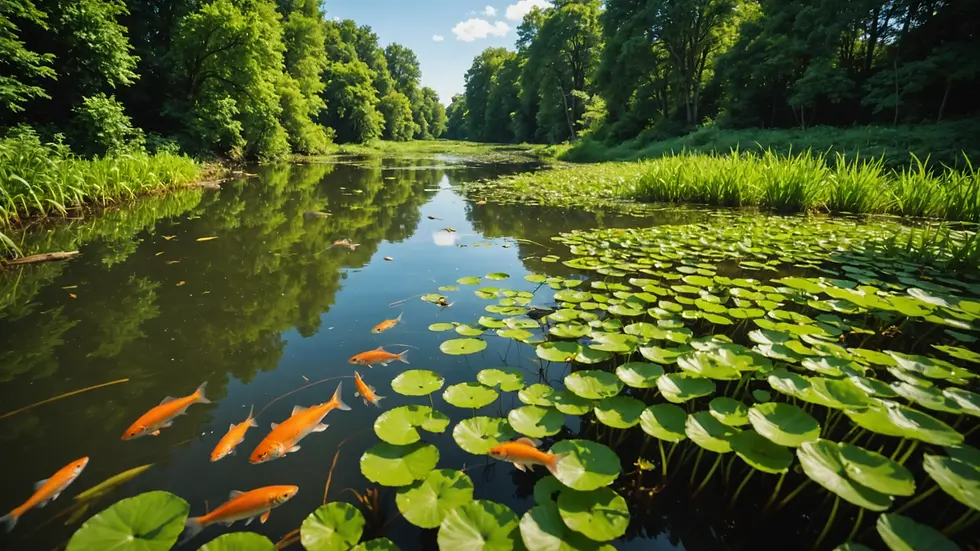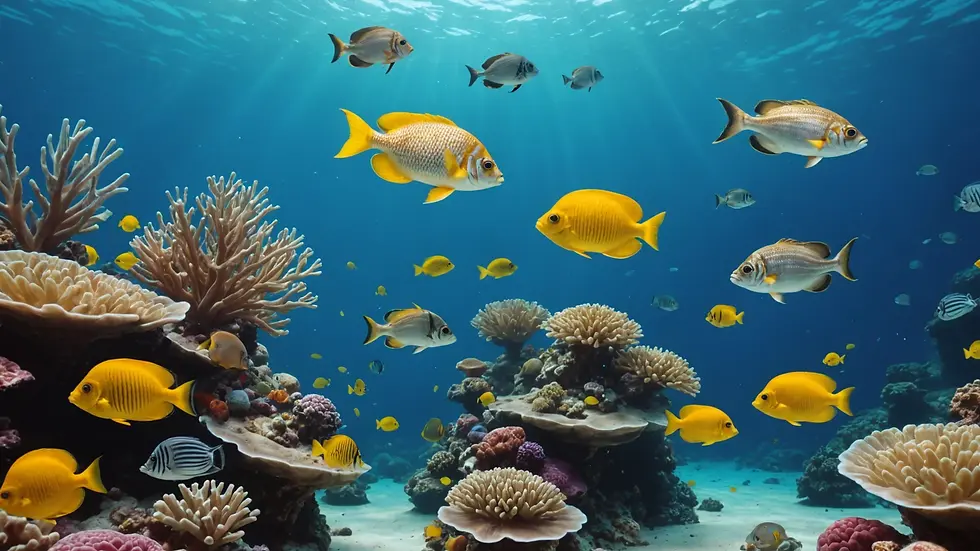Unraveling the Enigmatic Influence of Fish on Aquatic Ecosystems
- Jyotiraj Borah
- Feb 5
- 4 min read
Fish play a vital role in maintaining the delicate balance within aquatic ecosystems. With the number of species exceeding 34,000—including both freshwater and marine varieties—fish contribute to the overall health and vitality of our water bodies. Understanding how fish influence these environments is essential for conservation efforts, recreational fishing, and the sustainable use of aquatic resources.
The Diversity of Fish Species
The extraordinary diversity of fish is key to their ecological roles. Fish are adapted to various aquatic environments, from flowing rivers to stagnant ponds. Each species fulfills distinct functions. For instance, herbivorous fish like the parrotfish consume algae, which helps prevent overgrowth, maintaining clear waters that support coral reefs and other aquatic life.
In freshwater ecosystems, species such as the common carp can rapidly alter their environments. These fish can rapidly reproduce, and they can disrupt local ecosystems if not properly managed, demonstrating the importance of understanding the diverse roles fish play.
Image placeholder:

Feeding Relationships and Trophic Levels
Fish occupy different trophic levels in aquatic ecosystems, which reflects their roles in food webs. For example, carnivorous fish like the pike not only prey on smaller fish but also help regulate their populations, preventing overpopulation and the subsequent depletion of resources.
Herbivorous fish, such as the surgeonfish, consume large quantities of algae. Their feeding habits can reduce algae blooms that might otherwise deplete oxygen levels in the water. This complex feeding behavior establishes intricate relationships. A 2019 study found that ecosystems with a healthy balance of fish species showed a 40% increase in biodiversity compared to those with disrupted fish populations.
Disruptions in these feeding relationships can have long-lasting consequences. For example, overfishing of a top predator can lead to a surge in prey fish populations, creating too much competition for resources among themselves.
Nutrient Cycling
Fish are crucial players in nutrient cycling within aquatic ecosystems. By consuming food and releasing waste products, they contribute essential nutrients like nitrogen and phosphorus back into the water. This process promotes the growth of algae and aquatic plants, which are the foundation of the food web.
For instance, in a healthy lake ecosystem, fish waste can increase algae growth by up to 50%, providing food for smaller organisms and sustaining populations at various trophic levels. The cycle continues as smaller organisms consume these plants, further integrating fish into the aquatic nutrient web.
Image placeholder:

Habitat Structuring
Fish also shape their habitats, influencing the environments in which they reside. For example, salmon create spawning sites by turning over stones in riverbeds—a behavior that redistributes nutrients and can lead to greater plant and animal diversity.
Some fish, such as damselfish, create and maintain territories that provide shelter for smaller organisms. These structural changes foster enhanced biodiversity and contribute to ecosystem stability. A 2021 study highlighted that areas with abundant fish structural features had a 30% increase in species diversity compared to areas devoid of such structures.
The Impact of Invasive Species
Invasive fish species can dramatically disrupt local biodiversity. These non-native species often outcompete indigenous fish for resources, leading to declines in native populations. For example, the introduction of Asian carp into North American waterways has been linked to reductions of up to 90% in certain native fish populations.
Understanding the impacts of these invasive species is critical for effective management and conservation. Ongoing monitoring and evaluation are necessary to mitigate the harmful effects these species can impose on local ecosystems.
Image placeholder:

Fishing and Conservation
The role of fish extends beyond their ecosystems; they are also vital to human economies through recreational and commercial fishing. Sustainable practices are essential. For example, regulations like catch limits and seasonal closures can help fish populations remain stable. In fact, studies show that fish populations can rebound by 50% when sustainable practices are implemented.
Conservation efforts that protect crucial habitats, such as wetlands and coral reefs, are equally important. These areas are breeding grounds for many fish species and directly influence population health.
The Human-Fish Connection
The relationship between humans and fish is multifaceted. Across the globe, fish provide essential nutrition to billions of people. In many communities, fish are not just a food source; they are also tied to cultural practices and local identities.
For example, in coastal communities, traditional fishing activities play a crucial role in maintaining cultural heritage. It's important for those who rely on fish as a resource to engage in conservation strategies, thereby preserving both ecological and cultural sustainability.
Future Challenges and Research
The future of fish in aquatic ecosystems faces many challenges. Climate change is a significant threat, causing shifts in water temperature, acidity, and rainfall patterns that affect fish habitats and survival rates.
Pollution, particularly from agricultural runoff and plastic waste, further exacerbates these issues, often leading to poorer water quality and declines in fish populations. Addressing these challenges requires commitment to comprehensive research and innovative approaches for restoring aquatic ecosystems.
Investments in studies that explore fish behaviors and interactions with other species are crucial for informing effective conservation policies. An adaptive management approach enables resource managers to make informed decisions based on ongoing research findings.
A Call to Action
Fish are indispensable to the health of aquatic ecosystems. Their diverse roles—from nutrient cycling and habitat structuring to supporting food webs—underscore their significance in maintaining ecological balance.
As human activities continue to impact aquatic environments, recognizing the vital role of fish is essential for sustainable management and conservation efforts. By fostering a deeper appreciation of fish and their interconnected roles, we can better protect these invaluable ecosystems for future generations.
The influence of fish highlights the delicate interplay within nature, reminding us of our responsibility to safeguard our aquatic resources. Engaging in conservation and sustainable practices can ensure that fish—and the ecological functions they support—thrive for years to come.




Comments